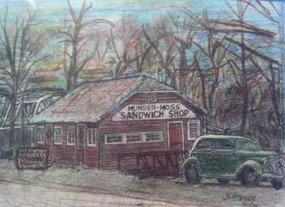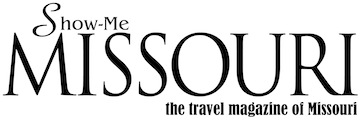Route 66 Hideaway
August 2014
by John Robinson
artist rendering of the original Munger-Moss (now the Elbow Inn) by Clarke Harvey
 I found a hideaway. When I rolled to its door, a thundershower was beating down on the low slung structure made mostly of logs with mud chinks, its back wall standing just a couple of feet above the swollen Big Piney River.
I found a hideaway. When I rolled to its door, a thundershower was beating down on the low slung structure made mostly of logs with mud chinks, its back wall standing just a couple of feet above the swollen Big Piney River.
It was still before lunch, and the neon beer signs were switched off. A dog with pit bull jaws and a decidedly defensive attitude greeted my car door. I sat frozen for a moment, undecided about dipping my leg out of the car to troll for jaws. Lightning flashed, and the dog spooked and retreated off into the shelter of the woods across the road. He knew he couldn’t bite thunder. I dashed through sheets of rain to the front door.
The Elbow Inn Bar and BBQ has been cranking out good times in one fashion or another since 1929, when folks called it the Munger Moss. Back then, there weren’t nearly as many motorcycles. Today, it’s a waypoint for every Harley Davidson rider who enters the Ozarks. And a watering hole for many of the soldiers who set foot in Ft. Leonard Wood, a short cab ride up the hill on old Route 66. The barbecue brings customers from as far away as Sweden. Most women walk into the bar wearing their brassieres; some leave without them.
I walked in and let my eyes adjust to the dim light that managed to penetrate through rainspattered windowpanes. A voice greeted me from beside the thick shellac that preserves the rust and cream colored wood of a classic cedar-top bar.
“Can I help you?”
“You open?” I opened.
“Kitchen’s closed, but the bar’s open.”
Terry Robertson is the perfect typecast for this historic bar. He’s a retired game warden who knows the area and its history, and he loves to visit with wayfarers. Two locals, long in the tooth, sat at the bar.
“Great place,” I offered, looking up at the low ceiling covered with a unique decor: dollar bills papered the ceiling, and hanging from it was a rainbow coalition of brassieres, liberated from the shoulders of a thousand women who got swept up in the moment in this living history museum.
In short order, the three men at the bar were volunteering everything they knew about the history of the place. This bar sits on the original Mother Road, now an appendage to the newer Route 66 that was carved through Hooker’s Cut in 1946, at the time the deepest road cut in the world. Now, even Hooker’s cut has been bypassed by Route 66’s granddaughter, I-44. The door swung open and two middle-aged men walked in.
“You open?”
“Kitchen’s closed, but the bar’s open,” Terry replied.
“Great! A round for everybody,” one of the men said. Terry obliged, pulling an unholy alliance of Miller Lites and Busch cans from the cooler, abstaining himself, as all good bartenders do before noon. The two men explained that they were from Chicago, a fact verified by their Ditka-esque accents. They were driving an old Ford Econoline van, and their goal was to drive the Mother Road from pier (Navy) to shining pier (Santa Monica). They knew about this roadhouse, and, within minutes, every member in this group was adding to the story of the Elbow Inn’s connection to the windy city. Al Capone used to send his henchmen down here to hide. A guy named Bud Medina was a regular here, they say, especially after his role as triggerman at the St. Valentine’s Day massacre in a Chicago warehouse. The name doesn’t show up in any history that I could find. But it probably was an alias. According to everybody at the bar, a whole rogue’s gallery of mobsters used to hang out here, in the middle of nowhere, while their trails in St. Louis and Chicago slowly iced over.
Lightning flashed, thunder crashed and the rain beat down harder on the old roof.
Time has been kind to the Elbow Inn; so has the Big Piney River, only occasionally threatening the old tavern with its floodwaters.
I thanked the bartender, offered best wishes to the Windy City wanderers, and walked out into the storm. The pit bull was still hiding from the lightning and thunder, and I jumped in the car to follow this ancient path that winds up the hill, across the interstate, from pier to shining pier.
Read more of John Robinson’s travel stories at JohnDrakeRobinson.com. His books, Coastal Missouri and A Road Trip Into America’s Hidden Heart are available at independent bookstores and online booksellers everywhere.
artist rendering of the original Munger-Moss (now the Elbow Inn) by Clarke Harvey

It was still before lunch, and the neon beer signs were switched off. A dog with pit bull jaws and a decidedly defensive attitude greeted my car door. I sat frozen for a moment, undecided about dipping my leg out of the car to troll for jaws. Lightning flashed, and the dog spooked and retreated off into the shelter of the woods across the road. He knew he couldn’t bite thunder. I dashed through sheets of rain to the front door.
The Elbow Inn Bar and BBQ has been cranking out good times in one fashion or another since 1929, when folks called it the Munger Moss. Back then, there weren’t nearly as many motorcycles. Today, it’s a waypoint for every Harley Davidson rider who enters the Ozarks. And a watering hole for many of the soldiers who set foot in Ft. Leonard Wood, a short cab ride up the hill on old Route 66. The barbecue brings customers from as far away as Sweden. Most women walk into the bar wearing their brassieres; some leave without them.
I walked in and let my eyes adjust to the dim light that managed to penetrate through rainspattered windowpanes. A voice greeted me from beside the thick shellac that preserves the rust and cream colored wood of a classic cedar-top bar.
“Can I help you?”
“You open?” I opened.
“Kitchen’s closed, but the bar’s open.”
Terry Robertson is the perfect typecast for this historic bar. He’s a retired game warden who knows the area and its history, and he loves to visit with wayfarers. Two locals, long in the tooth, sat at the bar.
“Great place,” I offered, looking up at the low ceiling covered with a unique decor: dollar bills papered the ceiling, and hanging from it was a rainbow coalition of brassieres, liberated from the shoulders of a thousand women who got swept up in the moment in this living history museum.
In short order, the three men at the bar were volunteering everything they knew about the history of the place. This bar sits on the original Mother Road, now an appendage to the newer Route 66 that was carved through Hooker’s Cut in 1946, at the time the deepest road cut in the world. Now, even Hooker’s cut has been bypassed by Route 66’s granddaughter, I-44. The door swung open and two middle-aged men walked in.
“You open?”
“Kitchen’s closed, but the bar’s open,” Terry replied.
“Great! A round for everybody,” one of the men said. Terry obliged, pulling an unholy alliance of Miller Lites and Busch cans from the cooler, abstaining himself, as all good bartenders do before noon. The two men explained that they were from Chicago, a fact verified by their Ditka-esque accents. They were driving an old Ford Econoline van, and their goal was to drive the Mother Road from pier (Navy) to shining pier (Santa Monica). They knew about this roadhouse, and, within minutes, every member in this group was adding to the story of the Elbow Inn’s connection to the windy city. Al Capone used to send his henchmen down here to hide. A guy named Bud Medina was a regular here, they say, especially after his role as triggerman at the St. Valentine’s Day massacre in a Chicago warehouse. The name doesn’t show up in any history that I could find. But it probably was an alias. According to everybody at the bar, a whole rogue’s gallery of mobsters used to hang out here, in the middle of nowhere, while their trails in St. Louis and Chicago slowly iced over.
Lightning flashed, thunder crashed and the rain beat down harder on the old roof.
Time has been kind to the Elbow Inn; so has the Big Piney River, only occasionally threatening the old tavern with its floodwaters.
I thanked the bartender, offered best wishes to the Windy City wanderers, and walked out into the storm. The pit bull was still hiding from the lightning and thunder, and I jumped in the car to follow this ancient path that winds up the hill, across the interstate, from pier to shining pier.
Read more of John Robinson’s travel stories at JohnDrakeRobinson.com. His books, Coastal Missouri and A Road Trip Into America’s Hidden Heart are available at independent bookstores and online booksellers everywhere.
